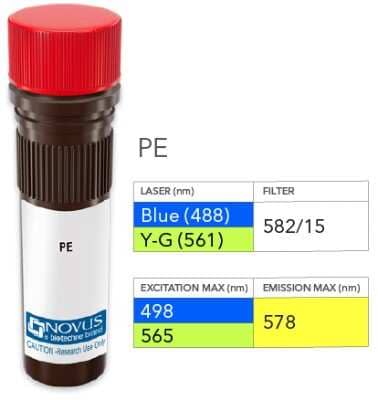B7-2/CD86 Antibody (BU63) [PE]
Novus Biologicals, part of Bio-Techne | Catalog # NBP2-34569PE
Clone BU63 was used by HLDA to establish CD designation.


Conjugate
Catalog #
Forumulation
Catalog #
Key Product Details
Species Reactivity
Human, Mouse, Rat
Applications
CyTOF-ready, Flow Cytometry, Immunocytochemistry/ Immunofluorescence, Immunohistochemistry, Immunohistochemistry-Frozen, Immunohistochemistry-Paraffin, Knockout Validated, Western Blot
Label
PE (Excitation = 488 nm, Emission = 575 nm)
Antibody Source
Monoclonal Mouse IgG1 kappa Clone # BU63
Concentration
Please see the vial label for concentration. If unlisted please contact technical services.
Product Specifications
Immunogen
ARH-77 (B-lymphoblastoid cell line)
Localization
Cell Surface
Marker
Dendritic Cells Maturation Marker
Clonality
Monoclonal
Host
Mouse
Isotype
IgG1 kappa
Description
This conjugate is made on demand. Actual recovery may vary from the stated volume of this product. The volume will be greater than or equal to the unit size stated on the datasheet.
Scientific Data Images for B7-2/CD86 Antibody (BU63) [PE]
Product Image: B7-2/CD86 Antibody (BU63) [PE] [NBP2-34569PE] - Vial of PE conjugated antibody. PE has two excitation maxima, 498 nm excited by the Blue laser (488 nm) and 565 nm excited by the Yellow-Green laser (561 nm). Both result in emission at 578 nm.
Applications for B7-2/CD86 Antibody (BU63) [PE]
Application
Recommended Usage
CyTOF-ready
Optimal dilutions of this antibody should be experimentally determined.
Flow Cytometry
Optimal dilutions of this antibody should be experimentally determined.
Immunocytochemistry/ Immunofluorescence
Optimal dilutions of this antibody should be experimentally determined.
Immunohistochemistry
Optimal dilutions of this antibody should be experimentally determined.
Immunohistochemistry-Frozen
Optimal dilutions of this antibody should be experimentally determined.
Immunohistochemistry-Paraffin
Optimal dilutions of this antibody should be experimentally determined.
Knockout Validated
Optimal dilutions of this antibody should be experimentally determined.
Western Blot
Optimal dilutions of this antibody should be experimentally determined.
Formulation, Preparation, and Storage
Purification
Protein G purified
Formulation
PBS
Preservative
0.05% Sodium Azide
Concentration
Please see the vial label for concentration. If unlisted please contact technical services.
Shipping
The product is shipped with polar packs. Upon receipt, store it immediately at the temperature recommended below.
Stability & Storage
Store at 4C in the dark.
Background: B7-2/CD86
References
1. Collins M, Ling V, Carreno BM. The B7 family of immune-regulatory ligands. Genome Biol. 2005;6(6):223. https://doi.org/10.1186/gb-2005-6-6-223
2. Greaves P, Gribben JG. The role of B7 family molecules in hematologic malignancy. Blood. 2013;121(5):734-744. https://doi.org/10.1182/blood-2012-10-385591
3. Bolandi N, Derakhshani A, Hemmat N, et al. The Positive and Negative Immunoregulatory Role of B7 Family: Promising Novel Targets in Gastric Cancer Treatment. Int J Mol Sci. 2021;22(19):10719. https://doi.org/10.3390/ijms221910719
4. Uniprot (P42081)
5. Bhatia S, Edidin M, Almo SC, Nathenson SG. B7-1 and B7-2: similar costimulatory ligands with different biochemical, oligomeric and signaling properties. Immunol Lett. 2006;104(1-2):70-75. https://doi.org/10.1016/j.imlet.2005.11.019
6. Ohue Y, Nishikawa H. Regulatory T (Treg) cells in cancer: Can Treg cells be a new therapeutic target?. Cancer Sci. 2019;110(7):2080-2089. https://doi.org/10.1111/cas.14069
7. Chen L, Flies DB. Molecular mechanisms of T cell co-stimulation and co-inhibition [published correction appears in Nat Rev Immunol. 2013 Jul;13(7):542]. Nat Rev Immunol. 2013;13(4):227-242. https://doi.org/1010.1038/nri3405
8. Karimi A, Alilou S, Mirzaei HR. Adverse Events Following Administration of Anti-CTLA4 Antibody Ipilimumab. Front Oncol. 2021;11:624780. https://doi.org/101010.3389/fonc.2021.624780
Alternate Names
B72, CD86
Gene Symbol
CD86
Additional B7-2/CD86 Products
Product Documents for B7-2/CD86 Antibody (BU63) [PE]
Product Specific Notices for B7-2/CD86 Antibody (BU63) [PE]
This product is for research use only and is not approved for use in humans or in clinical diagnosis. Primary Antibodies are guaranteed for 1 year from date of receipt.
